By the end of this post, you will understand what Effective Hit Points (eHP) are and how you can use eHP to make more durable teams—and win more games!
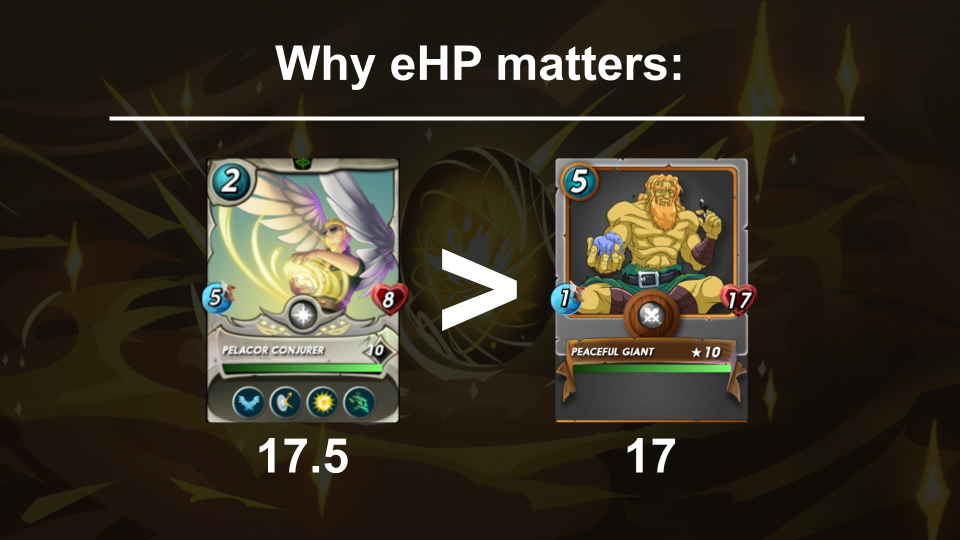
What is eHP?
Effective Hit Points (eHP) represents the amount of base damage a unit can mitigate in a single round before dying, taking into account abilities like Shield, Void, and Dodge (as well as many more). This is a foundational building block to analyze a single round, and we will consider multi-round scenarios later in this post.
For example, Peaceful Giant has 17 eHP. It is simple because there are no modifiers and no miss chance at 1 speed.
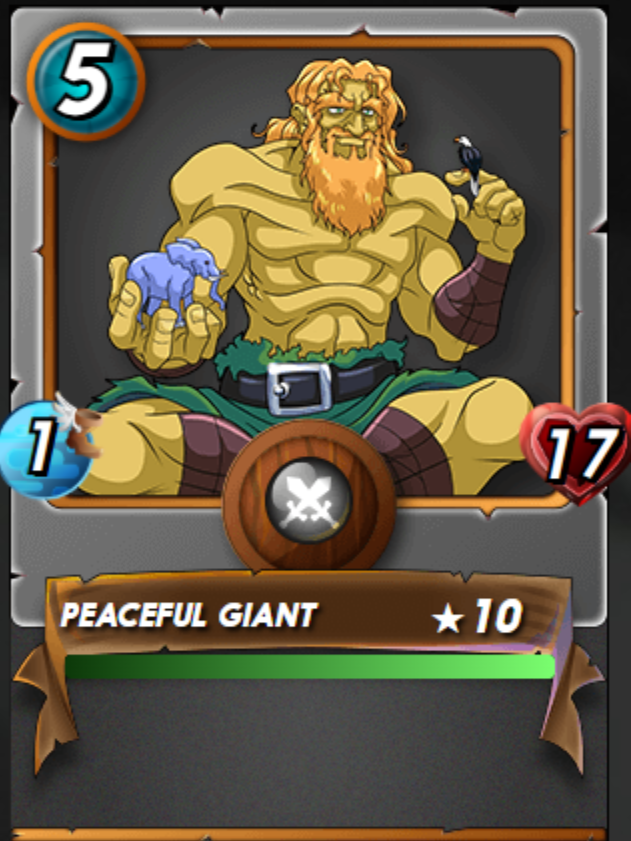
However, if the ruleset is Reverse Speed, Peaceful Giant gains eHP from misses—more on dodge later.
Damage Reduction
Two great examples of cards that reduce damage for more eHP are Lord Arianthus and Grimbardun Smith.
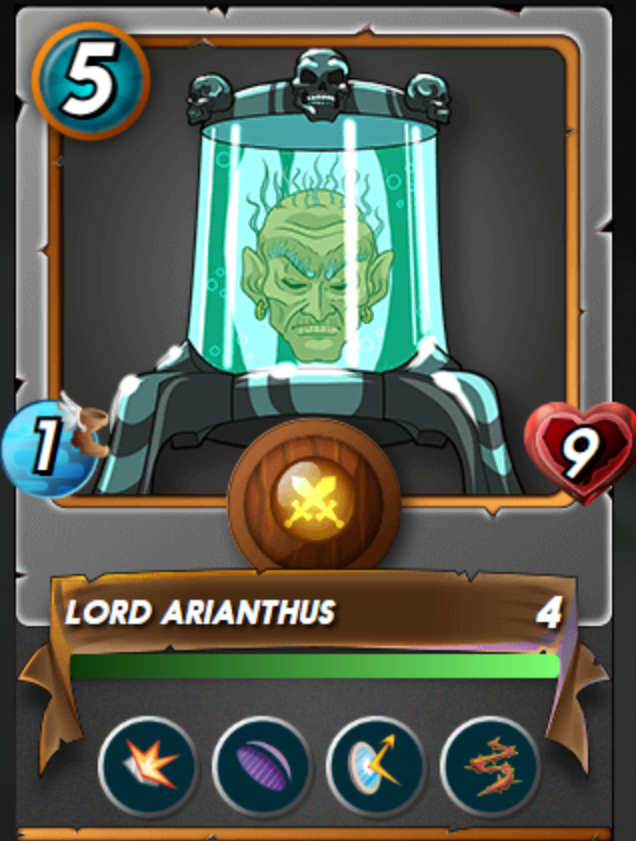
Since Lord Arianthus has a base HP of 9, and both Shield and Void, we can say that his eHP is 18. However, since damage is rounded up (except at 1 damage, where it is reduced to 0), the actual eHP can vary. For simplicity’s sake, we will use 18 as an estimate.
Grimbardun Smith has Armor as well, which we will explain later. For now, we will add it to the eHP.
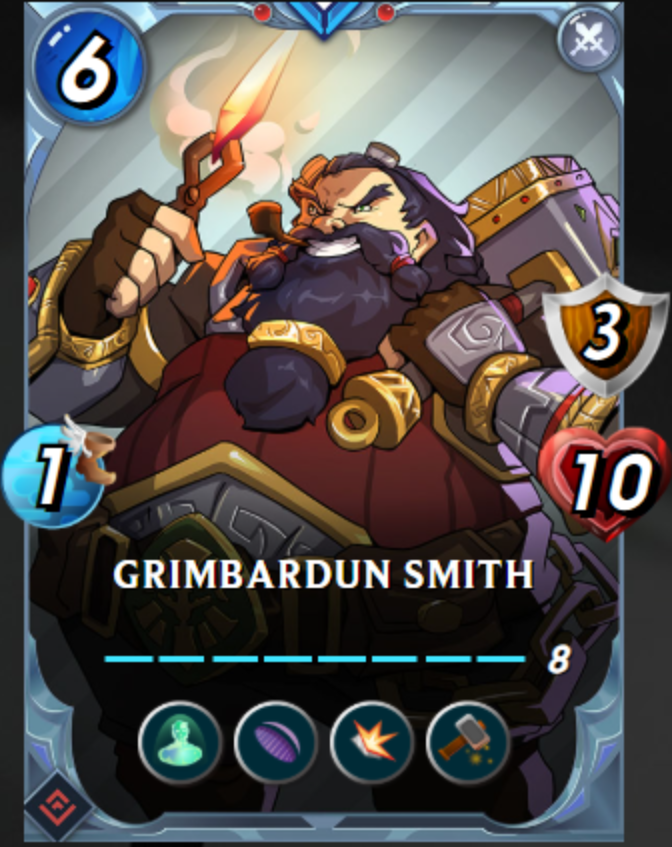
Repair can be seen as adding 2 extra armor to the base HP. So, to calculate Grimbardun Smith’s eHP, we would add the armor from repair for a total of 5 armor and 10 health. Add those to get 15. Then, since Shield and Void are there, double it for roughly 30 eHP.
Additionally, playing Tank Heal units like Venari Crystalsmith you could increase Smith’s eHP further
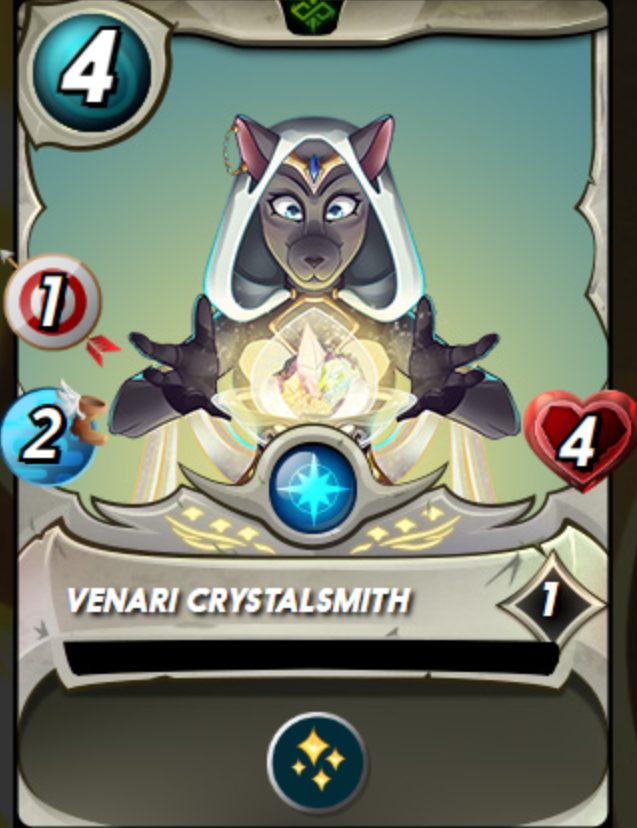
Grimbardun Smith would gain 3 base HP, doubled by Shield and Void to 6, for a whopping 36 eHP. To put that into perspective, Peaceful Giant would have an eHP of 22 with the same combo.
Fast Tanks
Now, I’d like to factor speed and dodge with Pelacor Conjurer:
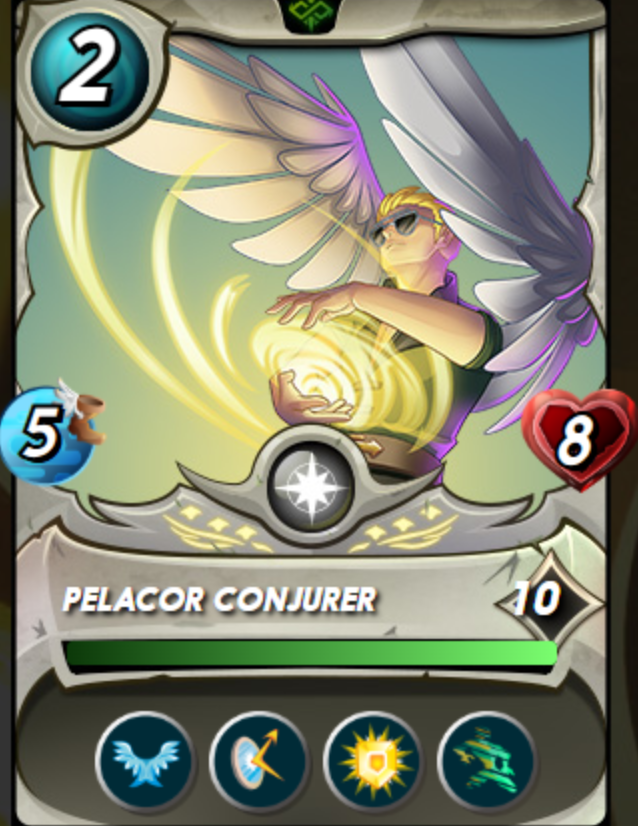
Let’s assume all enemy units have on average 3 speed. Since Pelacor Conjurer has Phase, both Physical/Magic attacks will have the same chance to miss. So at 5 speed and with flying, we can estimate a 45% miss chance. What do you think this does to Pelacor Conjurer’s eHP?
(8 + 3 [Divine Shield estimated value]) x (1 / (1 - 0.45)) = ~17.5
This is INSANE value for 2 mana. For just two mana, it has the same eHP as Peaceful Giant.
But what if the unit doesn’t have Phase?
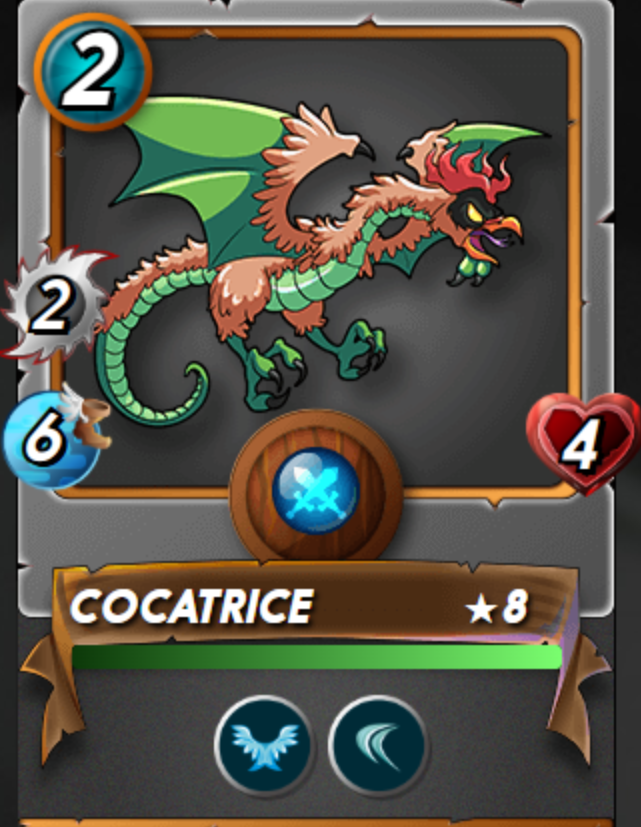
Magic attacks will still hit this, but non-flying Physical attacks at 3 speed will have a ridiculous 80% miss chance.
Because Physical and Magic damage have separate sets of ability interactions, I would like to split eHP into:
- Physical eHP (PeHP)
- Magic eHP (MeHP)
Yes, it’s weird, but try to get used to it. The acronyms only gets worse…
PeHP = 4 x (1 / 0.2) = 20 MeHP = 4 (because Magic always hits)
There is a 16-point eHP difference between PeHP and MeHP! So in rulesets like Lost Magic, you get huge value from Cocatrice. But usually, it takes just one Chaos Magi to say bye-bye to your chicken.
Recurring eHP
If you read my last post, you might be wondering how eHP fits into the Beatdown vs Control paradigm. Beatdown teams aim to have an early round 1 or round 2 Fundamental Turn, so this evaluation of the eHP is convenient for the archetype. However, Control prefers long, drawn-out games. Hence, we will also have another kind of eHP: Recurring eHP.
Now, we can add this to make two monsters of an acronym:
- RPeHP (Recurring Physical Effective Health)
- RMeHP (Recurring Magic Effective Health)
Recurring eHP is the the amount of healed/repaired heatlh/armor in terms of eHP from abilities like Tank Heal and Repair. For example, to calculate the Recurring eHPs of Commander Slade with Merdaali Guardian:
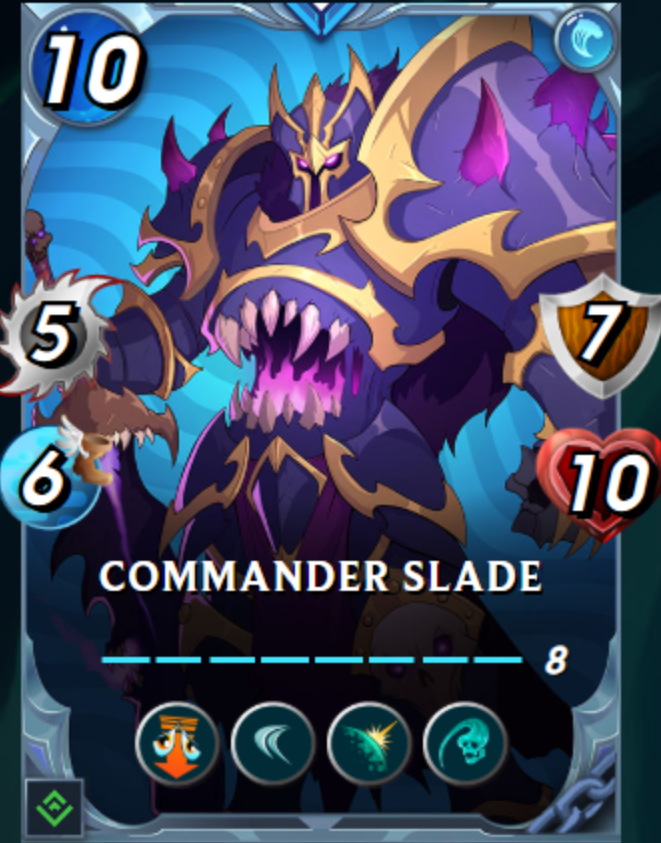
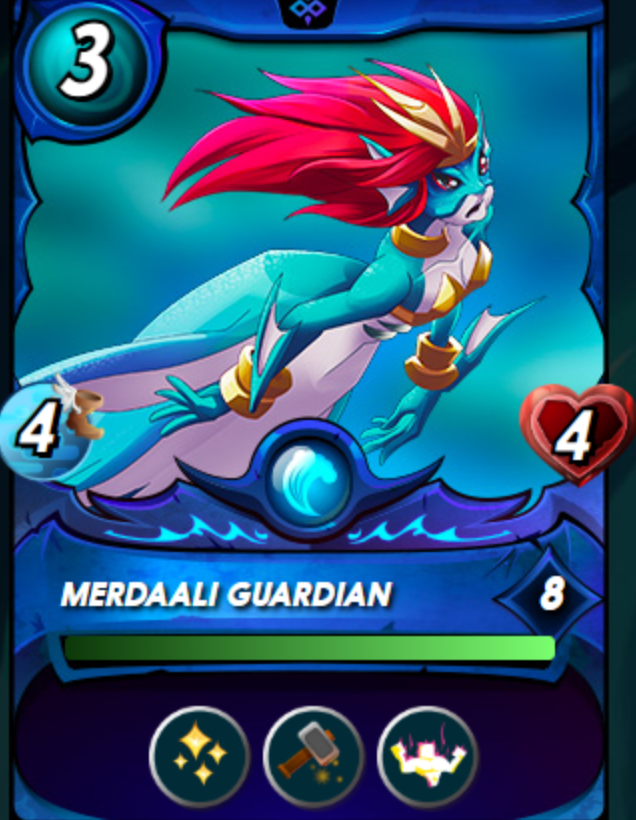
RPeHP: Base: Tank Heal 11 / 3 rounded down => 3 Repair 2 3 + 2 = 5 Recurring Physical HP Dodge chance = 0.3 + 0.25 = 0.55 5 x (1 / (1 - 0.55)) = ~11.1 RPeHP
RMeHP: Base: Tank Heal 11 / 3 rounded down => 3 No dodge chance 3 RMeHP.
Let’s see what a Cryptic and Rune Arcanist can do to these numbers…
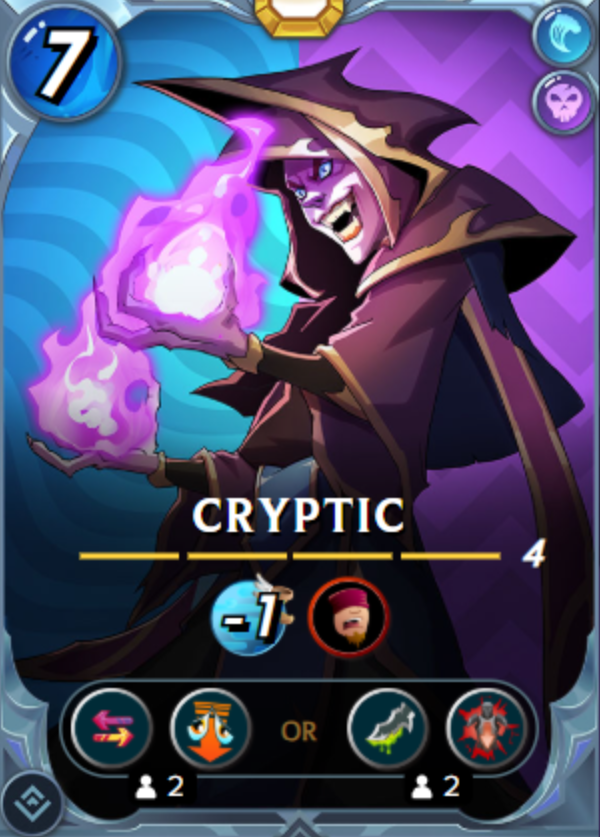
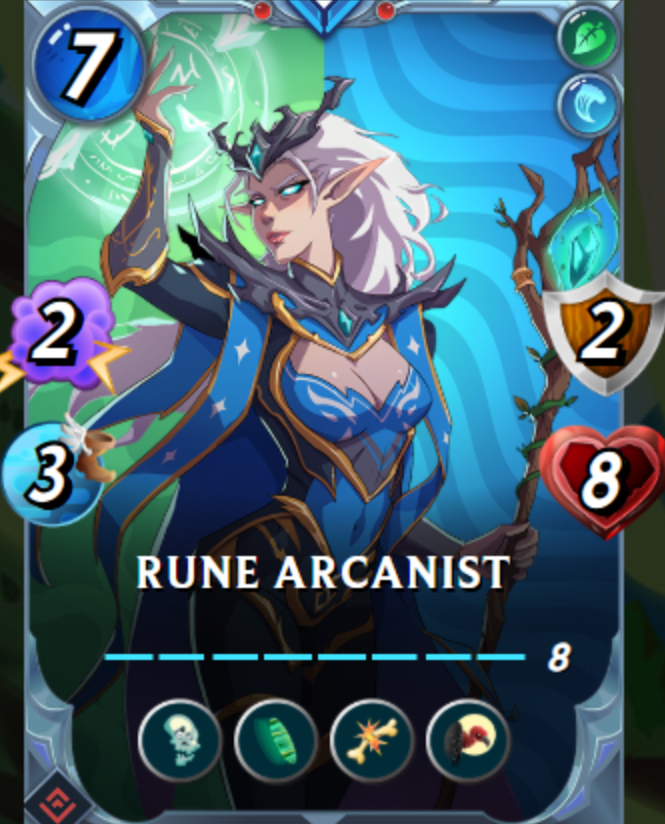
RPeHP calculation:
Tank Heal: 11 / 3 rounded down = 3
Repair: +2 armor 3 + 2 = 5 Recurring Physical HP
Dodge chance = 0.4 + 0.4 = 0.8
5 x (1 / (1 - 0.8)) = 25 RPeHP
RMeHP Base: Tank Heal 11 / 3 rounded down => 3
Dodge chance = 0.4 + 0.4 = 0.8
3 x (1 / (1 - 0.8)) = 15 RMeHP
Insane RMeHP values from one support unit.
Blind and 1 speed modifier increase dodge chance by 25%, while Phase Ward enables Commander Slade to dodge magic attacks, boosting the eHP values to 115 PeHP and 70 MeHP. Remember, Peaceful Giant, the highest HP unit in the entire game only has 17 eHP.
To recap and re-define
Effective HP (eHP) => the amount of base damage a unit can mitigate in a single turn before dying. Can be used as a shortcut when both damage types are expected and eHP isn’t greatly affected by damage type
Physical eHP (PeHP) => the same as eHP, but only factoring in Physical damage and resistance.
Magic eHP (MeHP) => the same as eHP, but only factoring in Magic damage and resistance.
Recurring eHP (RPeHP/RMeHP) => Instead of using the full HP/Armor, only account for armor and health that would be restored every turn (e.g. from Tank Heal and Repair). Particularly useful when evaluating control teams.
Additionally, the steps to calculate PeHP and MeHP per unit are as follows:
PeHP:
- Add armor and health
- Add health and armor gained from Strengthen, Protect, Summoner, and Repair
- Add health and armor regained from Heal, Tank Heal, Triage, Corrupted Heal, Resurrect, Rebirth, and Repair
- Multiply by
1 / (1 - dodge chance) - For enemy speed, I have used 3 as a placeholder value, but feel free to change it.
MeHP:
- Add health
- Add health gained from Strengthen
- Add health regained from Heal, Tank Heal, Triage, Corrupted Heal, Resurrect, and Rebirth
- If the unit has Void Armor, or the ruleset is Weak Magic, use PeHP calculation instead
- If the unit has Phase, multiply by
1 / (1 - dodge chance) - For enemy speed, I have used 3 as a placeholder value, but feel free to change it.
For the ReHP calculations, use the recurring regained armor/health from healing like Tank Heal and Repair instead of adding base health and armor
I’m sure there are some things I’ve missed with this, so feel free to let me know where I can clean it up in the comments.
Practical analysis
Now, I’d like to bring this analysis to actual games.
We will ignore the opponent’s buffs/debuffs for now; I want to focus on eHP during team selection phase.
Game 1:
https://splinterlands.com/battle/sl_536e524b08811392c4ccfa604f96f9d6?ref=doloknight
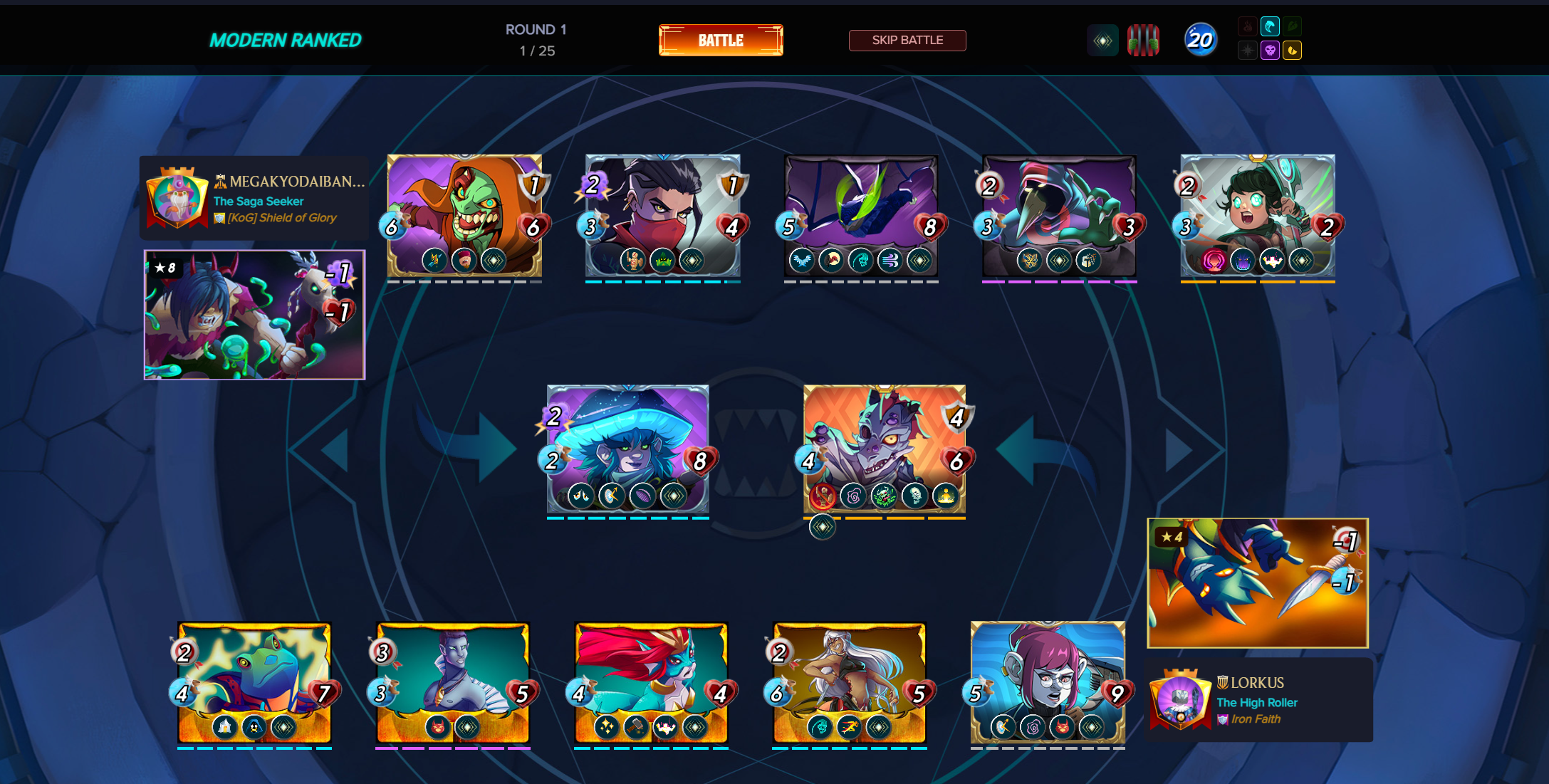
Who has the highest eHP? In this game, Player 2 (lorkus) has a main tank (Daigendark Surveyor) and a secondary tank (Ulfga), so we will calculate both of them. Since both teams are Beatdown, I will not calculate ReHP.
Starting with Megakyodaibanrai:
Dark Arborist MeHP:
8 x 2 = 16
Dark Arborist PeHP:
(8 + 1) x (1 / (1 - 0.15)) = ~10.6
Since Player 2 has only Physical damage (+ poison burst from Ulfga), the actual eHP follows the PeHP of 10.6.
Moving on to Lorkus:
Ulfga the Blighted MeHP:
(6 + 1 + 1 + 2) = 10
Ulfga the Blighted PeHP:
(10 + 1 + 1 + 2 + 2) = 16
Dodge chance = 0.1 + 0.1 + 0.1 + 0.1 = 0.4
16 x (1 / (1 - 0.4)) = ~26.7
Ulfga has low MeHP, so Daigendark Surveyor was added as well:
Daigendark Surveyor MeHP:
10 + 3 = 13
Daigendark Surveyor PeHP:
Dodge chance = 0.5
13 x (1 / (1 - 0.5)) = 26
Player 2 has a combined PeHP of 52.8; five times as much as Player 1’s 10.6.
Who do you think wins this battle?
Game 2:
https://splinterlands.com/battle/sl_397067b60e980db9d9baffb8e7bb690f?ref=doloknight
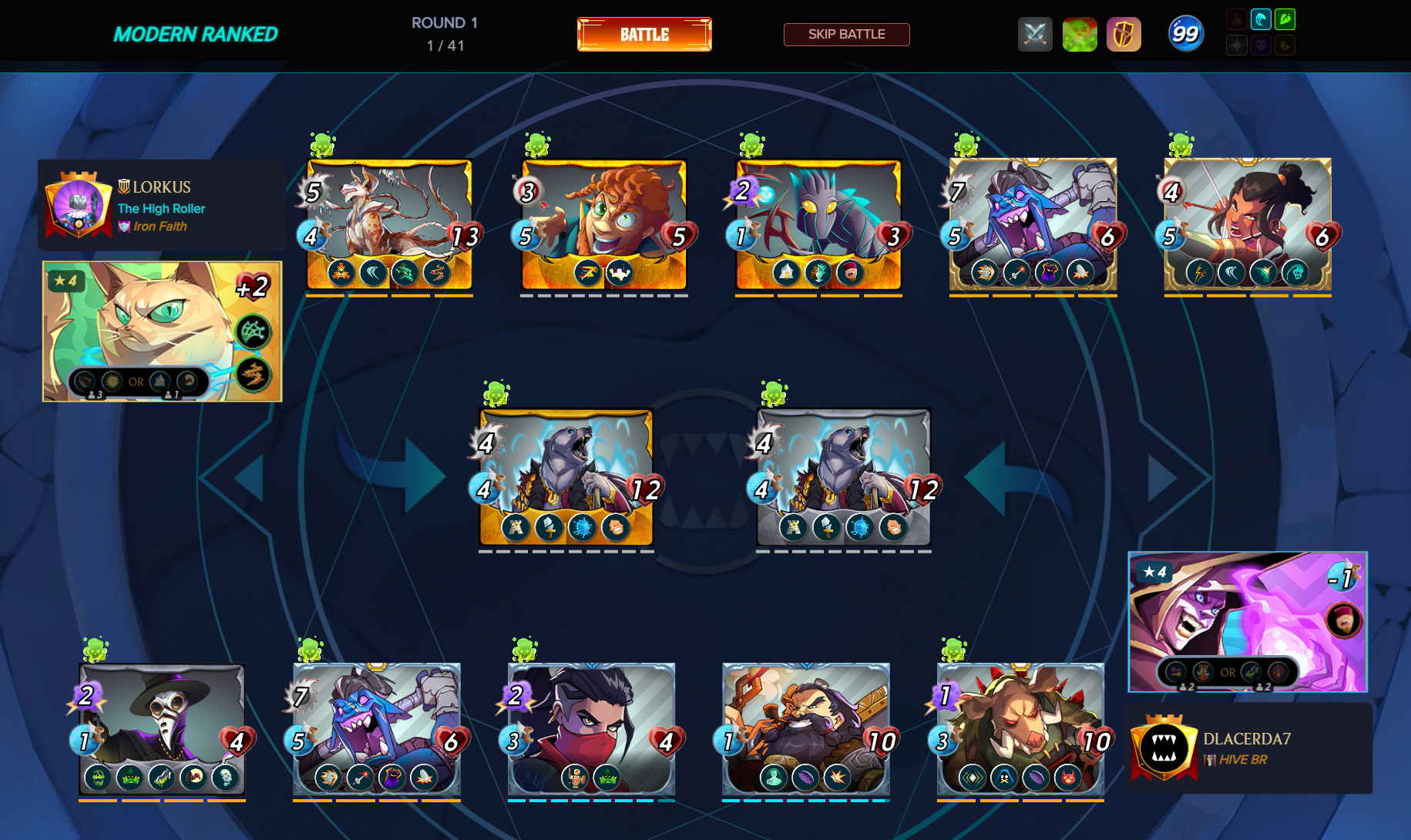
Lorkus has an eHP of:
Arkemis the Bear = ~27.3 PeHP/15 MeHP
Coeurl Lurker = 40 PeHP/40 MeHP
For a total of 67.3 / 55
Dlacerda7 has an eHP of:
Arkemis the Bear = ~21.8 PeHP/12 MeHP
Nalara Geinek = ~13.3 PeHP/20 MeHP
Grimbardun Smith = 20 PeHP/20 MeHP
For a total of 55.1 / 52
Without even accounting for damage, Lorkus already has a greater eHP. But eHP was not the deciding factor in this game. In Beatdown vs. Beatdown scenarios, speed and damage are just as important as eHP. Here, Lorkus gets Momentum with the first kill with Delya, Arkemis, and Supply Runner attacking first. Damage is the other side of the coin.
Analysis
I also analyzed 631 cards in this spreadsheet: https://docs.google.com/spreadsheets/d/1U2wVPy9J6OE3j-AbOluSfrHcYg8WC_74QkY2Xb3BCCM/edit?usp=sharing. Take these numbers with a grain of salt, because some assumptions were made; I set variable life gain abilities like Scavenger and Life Leech at 1 and 2 additional HP, respectively.
Here are the top 20 cards with the highest PeHP:
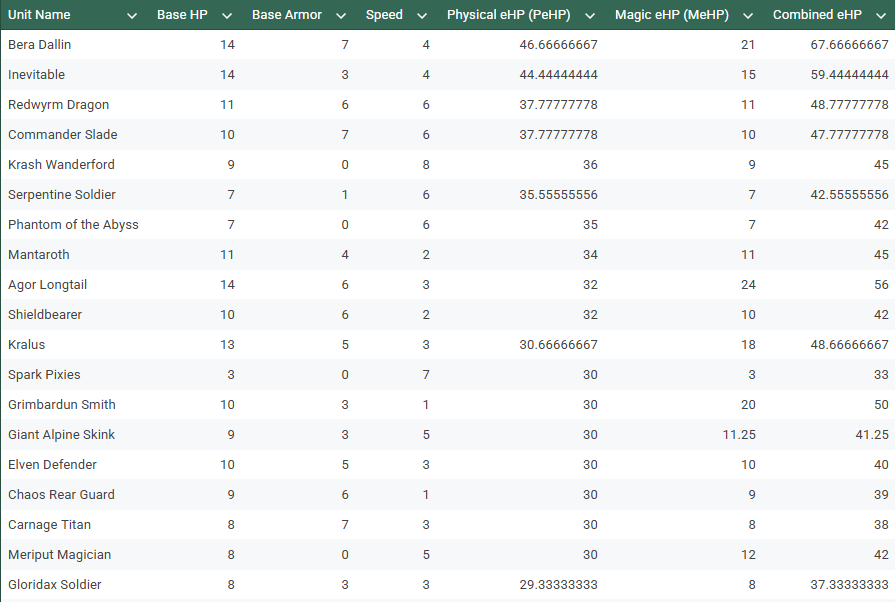
And the top 20 cards with the highest MeHP:
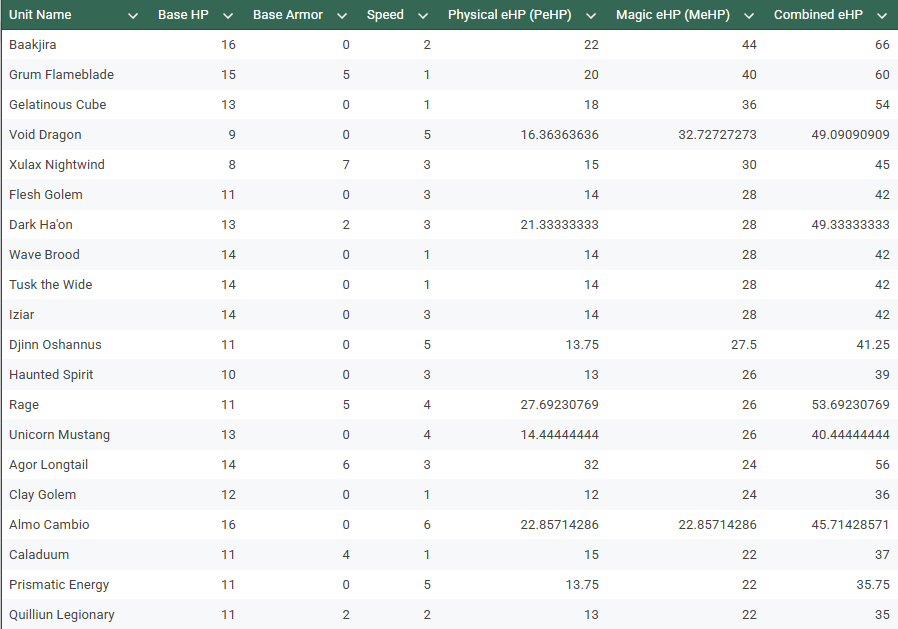
Top 20 cards with the highest RPeHP:
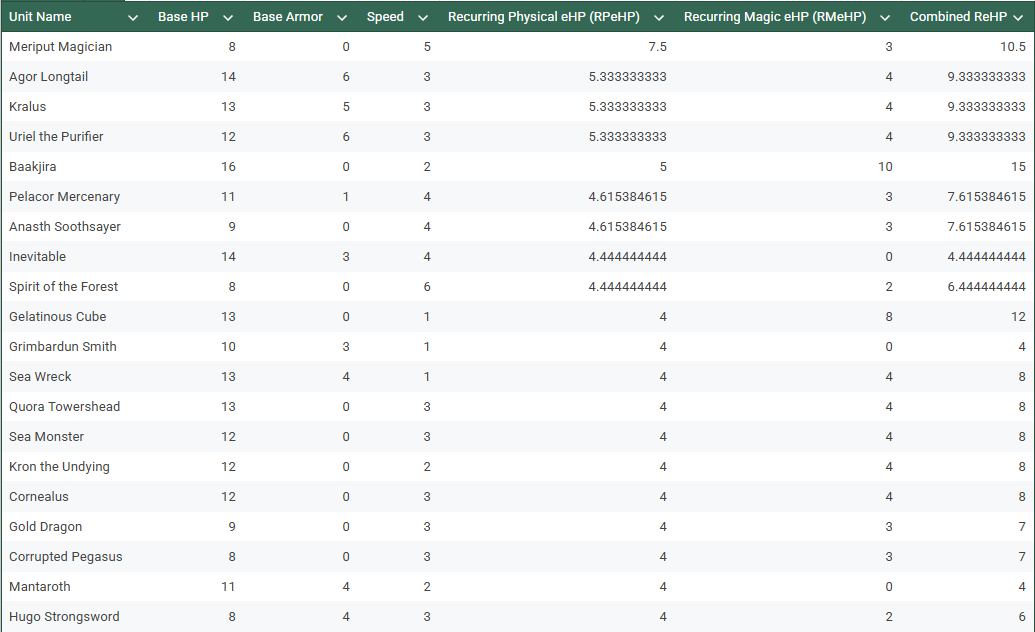
Top 20 cards with the highest RMeHP:
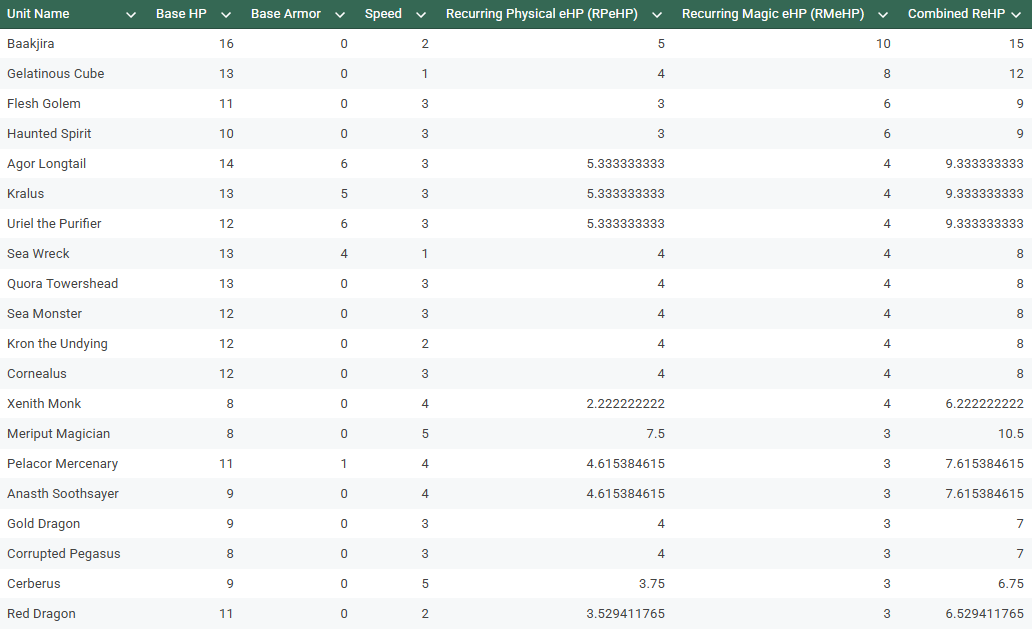
Conclusion
eHP is an imperfect but useful framework for evaluating tanks. Breaking eHP down into its Physical and Magic components helps us understand how different abilities and speeds affect the durability of certain tanks. To use this tool effectively, try to remember the rough MeHP/PeHP of key tanks and estimate it on the fly. This way, no matter the ruleset, you can choose the best tank.
As a note, many high speed units can be boosted to ridiculous eHP levels with Swiftness, Slow, and Blind. The earlier example with Slade + Cryptic is probably the most obvious, but I’m sure there are other great ones too.
Remember that eHP is not the only factor that determines the outcome of a given match. The other side of the coin is damage and speed. This is only the beginning.